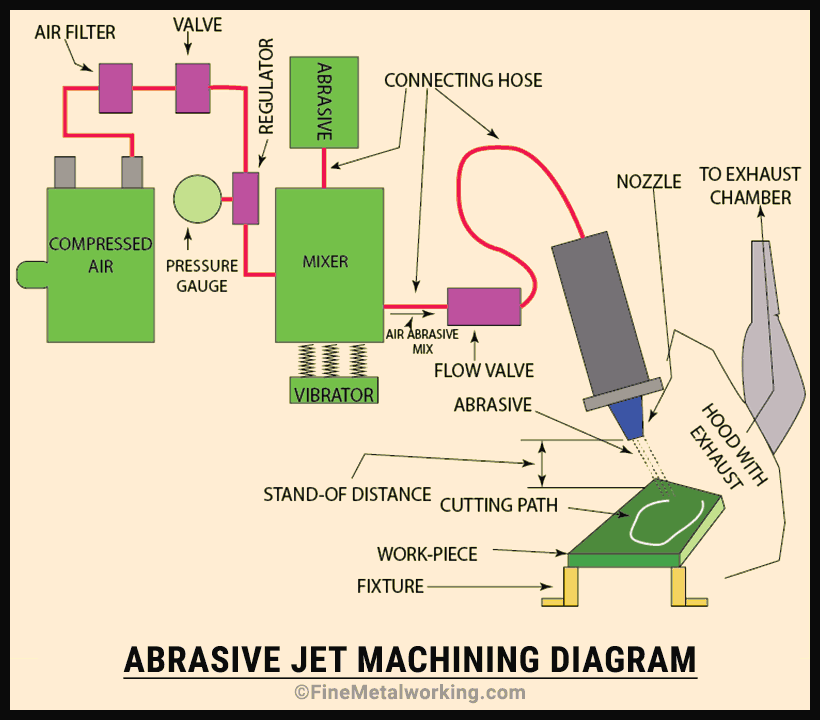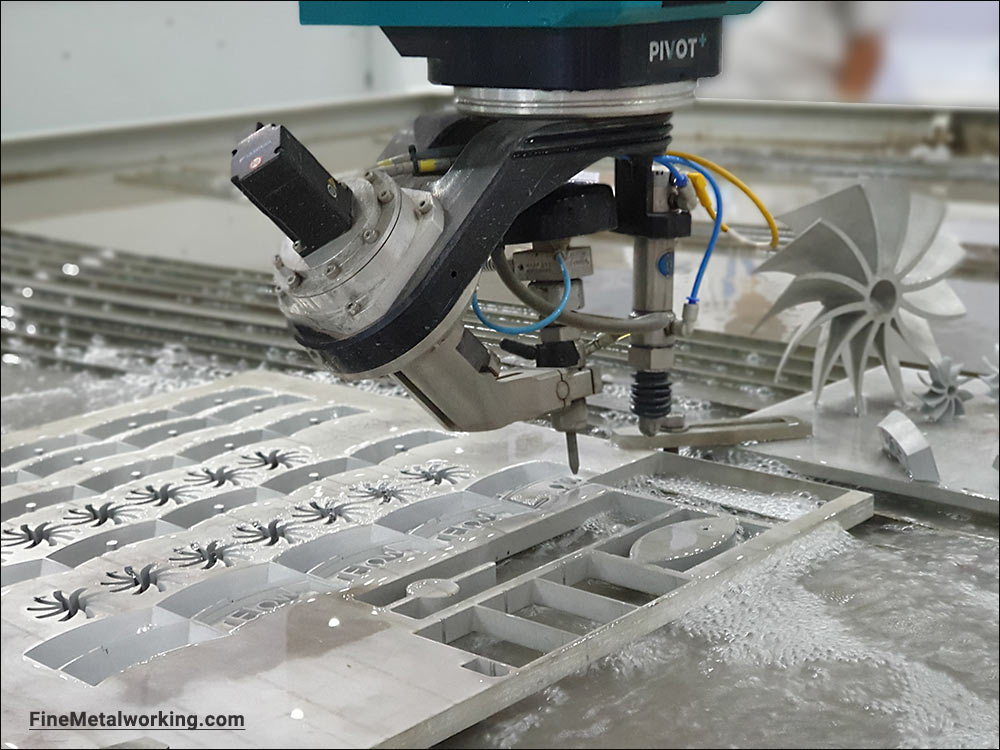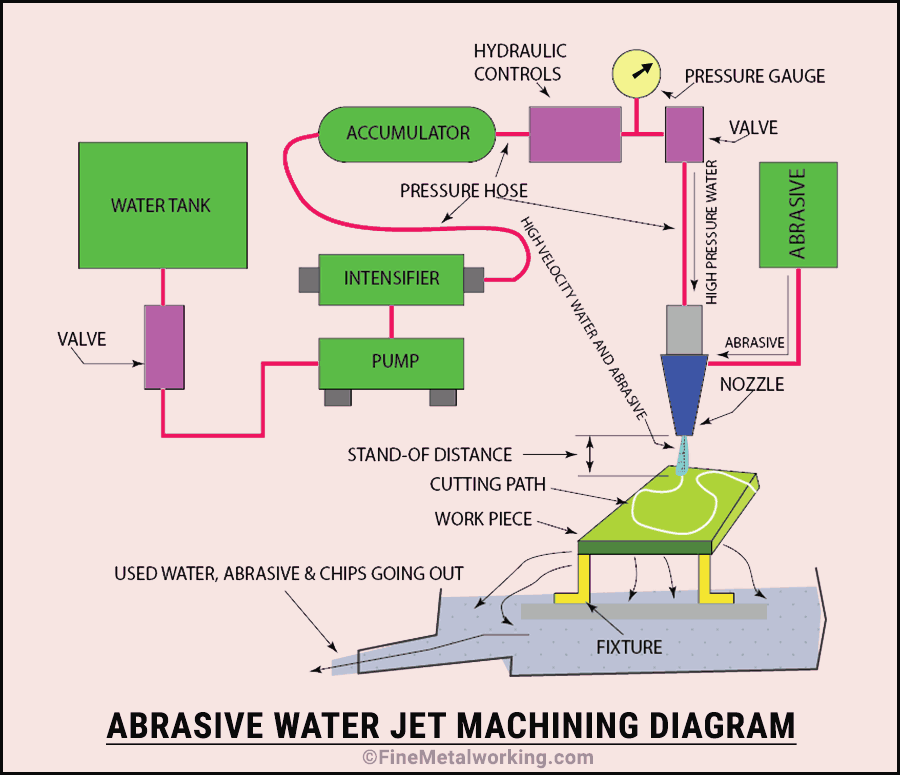Water jet cutter works on the principle of abrasive water jet machining where pressurized water with abrasive particles is used for cutting various materials.
We are all aware of the power of water, both constructive and destructive. In many countries, the generation of electric power started with hydel power plants where electricity is generated by the turbines run by the falling water from a height.
Water Jet Machining (WJM) is a non-traditional machining process where the power of water in the form of a high-velocity water jet is used for cutting the material.
When you add abrasive particles to the high-velocity water jet, the process is called Abrasive Water Jet Machining (AWJM); the abrasive particles in the water jet improves the cutting and machining action.
Page Contents
What is Abrasive Jet Machining?
Abrasive Jet Machining (AJM) is a mechanical machining process where you cut or machine the workpiece by impacting a stream of high-velocity air (or gas, the air is normally used) carrying abrasive particles, on the work-piece surface. The abrasive particles are driven by a high velocity (about 180 to 200 meters per second) of air.
The work-piece material of your AJM is stressed and fractured at the point of impact and with continued impact, the fractured particles get separated from the work-piece surface (due to chipping action and erosion); the air in the abrasive jet, carries away the fractured particles. This process happens continuously in your AJM and the material is cut as per the desired profile; the chipping and erosion of material happen better when the material is hard and brittle.
The factors affecting Abrasive Jet Machining are:
- The composition of the abrasive and air mixture and the type of abrasive.
- The distance between the nozzle tip and the work-piece surface, called SOD (Stand-of Distance).
- Angle of striking of the abrasive jet.
AS SOD in your AJM increases, the cutting width increases, and efficiency comes down. With higher SOD the abrasive particles lose some energy.
The effect of waterjet is more prominent in cutting brittle materials like glass and ceramic since the surface fracture happens faster under the impact of abrasive jet; it is also more effective for cutting and machining of tungsten and tungsten-carbide which are difficult to machine by conventional methods.
Abrasive Jet Machining is used for cutting intricate profiles. The edges cut by your AJM process is free from chatter marks or heat affected zone in the cutting area since there is no cutting tool or cutting forces involved in this process.
Working Principle of Abrasive Jet Machining
The abrasive jet machining system consists of:
- Compressed gas (air or other gas like nitrogen, carbon dioxide, organ etc.), normally air is used
- Air filter, pressure regulator valve, pressure gauge, and pressure hoses between the compressed air chamber and the mixer
- Cutting nozzle
- Flow control valve and pressure hoses between the mixer and cutting nozzle
- Abrasive grains and
- Exhaust system.
The mixer of the waterjet cutter gets abrasive particles from its source and the compressed air mixed with abrasive particles are allowed to pass to the cutting nozzle through a flow control valve; the mixer is continuously kept under vibration.
The abrasive jet nozzle of your AJM can be operated manually or using a robot or on a machine; when used on a machine the movement of the nozzle can be CNC controlled or robot-controlled for cutting accurate profiles.
One serious issue in the AJM is how to control the abrasive particles flying out after cutting? The abrasive particles are harmful to human health and inhaling the particles will cause health problems. Hence, the machine also needs a hood and exhaust system to take away the used abrasive particles along with the air.
How Water Jet Cutting Machine works?
The Water Jet Machine (WJM) uses a stream of high-pressure water converted to a high-velocity water jet as a cutting tool to machine and cut the materials; the water jet comes out of the nozzle at a very high velocity and strikes the point of cutting on the work-piece.
The impact of the high-velocity water jet of your WJM and its kinetic energy creates a crack in the work-piece material leading to material failure and material particles breaking away from the work-piece surface. This process of material cracking, failing, and separating from the workpiece continues in your WJM and the material is cut as per the required profile.
The water in your WJM process enters the nozzle at high pressure and comes out of the nozzle orifice (0.2 to 0.5 mm) at high velocity (800 to 1000 meters/second).
Your WJM process can machine and cut any material from rubber to metals and this is a preferred method for cutting hard and brittle materials and rubber-like materials.
The water jet of your WJM takes away the metal particles (chips) and goes out through the drain system for further filtering and recycling; a mist of water may be created near the cutting area and the instruments in this area need to be protected.
To enhance the cutting efficiency of your WJM process, abrasive particles are introduced into the high-pressure stream of water and this machining process is called Abrasive Water Jet Machining (AWJM).
Abrasive Water Jet Machining uses the system of your WJM by adding abrasive particles to the high-pressure water stream and hence it is considered as an extension of WJM.
Systems of WJM and AWJM
Major components of your WJM or AWJM are (i) high pressure pump (ii)Intensifier (iii) Accumulator (iv) high pressure connecting hoses (v) nozzle & orifice (vi) control system(for controlling the quantity and pressure of water, and abrasive quantity) and (vii) drain system to take away water, abrasives and chips (after machining).
The high-pressure pump of your machine, aided by the intensifier increases the water pressure to the range of 1500 to 4000 bars; the accumulator ensures the availability of high pressure water without fluctuations and the high-pressure hose does the work of safe transmit of high-pressure water to the nozzle and allows the movement of the nozzle in the cutting path.
The nozzle and its orifice of your WJM and AWJM is a critical component and subject to high wear due to the flow of water or water and abrasive at high velocity; the nozzles are generally made from Sapphire or tungsten carbide. The drain of your WJM and AWJM helps faster removal of the used water and abrasive particles along with chips and helps to reduce the noise produced by the system.
Types of Abrasive Water Jet Machines
The water jets can be classified into two types,
- Entrained type
- Suspended type
In the entrained type the abrasive particles are added in the nozzle to the high-pressure stream of water.
In the suspended type the abrasive and water are mixed and a high-pressure slurry of water mixed with abrasive is supplied to the nozzle.
Cutting Efficiency
The efficiency of cutting / machining of your WJM and AWJM depends on:
- The nozzle diameter and the SOD (stand-of distance between the nozzle tip and work-piece surface).
- Pressure/velocity of water.
- Work-piece material and its thickness and feed rate.
- Abrasive type and grain size.
Abrasives used in Waterjet Cutter
The most common abrasives used in abrasive water jet machines are aluminum oxide, silica sand, Silicon carbide, garnet, etc. Silicon carbide is preferred for cutting hard materials.
The AWJM uses coarser grains (60 to 80 mesh) for higher cutting speed and finer grains (100 to 150 mesh) for a smooth finish.
Advantages of Abrasive Water Jet cutting
Following are the advantages of your WJM and AWJM processes.
- Materials where the excess heat generated during the cutting alters the material property, like tool steels, can be cut safely by your WJM or AWJM process.
- WJM or AWJM does not create a heat-affected zone (HAZ).
- Materials cut by WJM or AWJM does not, generally require secondary operations like deburring.
- Cutting forces generated in WJM and AWJM process is low.
- Requirement of tooling is limited. You can achieve a Ra (surface finish) value of 150 to 250 microns.
- Low material wastage due to less cutting width (kerf).
- There is no tool wear and hence no cost of tool re-sharpening.
- AWJM and WJM can cut soft materials like rubber, metals, hard and brittle materials like ceramic and glass, composites, and non-metals like plastics and stones.
- AWJM process is ideal for cutting reflective metals like aluminum and copper, which pose difficulties for Laser.
- The fixtures needed in WJM and AWJM are very simple compared to conventional machines.
- AWJM can start cutting at any point (starting hole is not required).
Disadvantages of Abrasive Water Jet Machining
Following are the disadvantages of your WJM and AWJM
- AWJM and WJM cannot cut materials that get affected or deteriorate with water.
- Higher cutting speeds are possible at the cost of surface finish.
- AWJM and WJM cut the material by creating and propagating cracks at the point of cutting (due to the impact of a high-velocity jet of water and abrasive). While cutting brittle material, the cracks may extend to other than the cutting path, and hence extra care and caution are required.
- Waterjet process is not accurate for cutting higher thickness material since it cuts taper. Because of this waterjet cutters are usually limited to cutting sheet metals and materials with thickness up to 4 inches.
- Initial cost of your AWJM/WJM equipment is more and hence a thorough evaluation of its utility and returns is necessary before making a decision.
- Your WJM/AWJM uses high pressure and high-velocity water which increases the noise level and safety concerns.
What Can You Cut on Abrasive Water Jet?
Following are some of the materials that you can cut with an abrasive water jet machine.
- It can cut both soft and hard materials like foam, rubber, composite materials, leather, metals, different types of plastics and stones.
- AWJM or Abrasive water jet machining is the preferred method of cutting soft materials like rubber which are difficult to cut using other methods.
- This water jet cutting is very useful when working with hard material that do not conduct electricity. These non-conducting materials cannot be machined by electrical discharge machining process such as Wire EDM or Sinker EDM.
- Since the AWJM cuts the material by inducing cracks with the impact of the high-velocity water jet, it may not be a preferred cutting method for hard and brittle metals, since the cracks may stray away from the path of cutting.
Uses of Abrasive Water Jet Cutter
Here are some of the examples of water jet cutting applications to understand how useful the process can be.
- Fabrication and manufacturing industry: The cut edge produced by your AWJM is free of burrs and burn marks, and can be directly used for further operations like fabrication, pressing, forming, etc.
- Your AWJM/WJM process eliminates some of the problems faced in the thermal cutting of metals like edge defects, edge hardening, and reduction in weldability and machinability.
- Your AWJM/WJM can machine or cut hard brittle materials like glass and ceramic and also soft materials like rubber, it is considered advantageous for cutting rubber-like materials which are difficult to cut by other processes.
- Space and aviation industries are the first to adopt and use your WJM and AWJM processes.
- Your AWJM/WJM is used for cutting tough materials like stainless steel, titanium, and tool materials like Inconel and composite materials (used in aircraft).
- Your AWJM/WJM process is used for cutting holes, both straight and at an angle.
- Your AWJM/WJM is used for high speed and high accuracy cutting of PCBs (printed circuit boards).
- Your AWJM/WJM can use CNC technology to cut any shape or any profile.
- Your AWJM/WJM is used for removing undesired coatings of rust and old paint etc. from the metal and casting surface.
- Your AWJM is used for surface texturing in the automobile industry.
Conclusion
Your Water Jet Machining and Abrasive Water Jet Machining are non-traditional methods of machining and cutting which are extensively used in the fabrication and manufacturing industry, including the aerospace and electronics industry.




